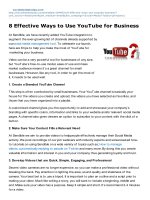Why Use Video For Your Online Business pptx
Bạn đang xem bản rút gọn của tài liệu. Xem và tải ngay bản đầy đủ của tài liệu tại đây (282.14 KB, 57 trang )
1
Why Use Video For Your Online Business?
Sigurd Kvernmoen
©2013 by CINéSYN
Published by CINéSYN at Smashwords
CINéSYN is a video production company. Visit us at
www.cinesyn.com.
1
Contents
1 Introduction 3
2 Some Startling Statistics 7
3 Building rapport with potential customers 9
4 Showing off products and services 13
5 Nothing Beats Video for Educating the Consumer
17
6 Video is More Easily Syndicated 21
7 Increasing Interest in Your Website 24
8 People Remember Video Better 29
9 Engaging customers with your brand 34
10 Video Increased Google Rankings 36
11 Video Increases Sales 40
12 Your Competitors are Using Video 45
13 Finding the Right Video Production Professional
47
14 Introducing CINéSYN 49
1 Introduction
In recent years, video has all but taken over the World
Wide Web. Whereas a few short years ago, it was a
technological challenge to put a short, tiny video on a
website, making those websites special; today websites
are expected to provide video content for their viewers.
In fact, for many people, websites which don’t have
videos are considered “old fashioned,” “out of touch”
and “just plain boring.”
This incredible change has been brought about by two
major technological breakthroughs in the Internet. The
first was the switchover from dial-up modem Internet
service to broadband service. This allowed the bandwidth
necessary to stream video content to anyone who had
broadband service. The second breakthrough was the
opening of YouTube.com. Starting in 2005, YouTube
provided anyone with the capability of uploading their
videos to the Internet, sharing those videos and
embedding them in their own web pages.
YouTube grew explosively, so rapidly that the Internet
giant, Google, bought them out for $1.65 billion dollars a
mere 21 months after launching. Today, YouTube is second
only to Google for the most visits per month. This alone
should serve as a wakeup call to anyone in business;
people want to see videos on the Internet.
In fact, video on the Internet has become so popular
that there are some remarkable statistics about YouTube
which you need to know:
· 35 hours of video footage is uploaded to the site
every minute.
· Each week, YouTube receives the equivalent of
115,000 full-length feature films in uploads.
· Over 13 million hours of footage was uploaded in
2010.
· More video is uploaded every 60 days than the
three major US television networks produced in 60
years.
· The most popular video of all time on YouTube has
had been viewed over 1.2 billion times.
With these types of statistics, it’s not a wonder that
people are using video for their businesses; what’s
amazing that some businesses still aren’t using it. While
YouTube doesn’t represent the entire video audience on
the Internet, it does represent about 47% of it.
Many of the most popular videos on YouTube are
professionally recorded music videos of the type that are
seen on MTV. Nevertheless, there are also some popular
videos which are poorly recorded videos made in
someone’s home with a handheld camcorder. Of these,
the most popular boasts over 500 million views!
Today’s society wants to be entertained. Video is a
much better medium for accomplishing this than other
mediums used over the Internet. While some people surf
the ‘Net looking for information, many just do so looking
for something that will catch their interest, distract them
from life and maybe give them a laugh. When companies
create entertaining videos and put them on their
websites, it provides an incredible hook to bring in
potential customers.
Entertainment has long been an effective part of
advertising. If you don’t believe me, take a look at the
second Superbowl competition. While the teams are
battling it out on the gridiron, other teams are battling it
out in the commercials. Each of these thirty second
spots, for which their companies pay $4 million (for
Superbowl 47), is worthy of the Academy Awards.
Millions of viewers watch, rate and vote on those
commercials, making a secondary competition that is
even more serious than the main event. To ensure that
they get their money’s worth; the corporate sponsors of
those commercials spend a small fortune to make them as
entertaining as possible. They want viewers to watch
their commercials, not to take that time as an
opportunity to run to the fridge. In 2013, for the first
time ever, teasers for the commercials were leaked
before the Superbowl, one of which garnered over a
million YouTube views before the day of the game.
For those who are old enough, who can ever forget
AlkaSelzer’s famous commercials from the 1960s? “Plop,
plop, fizz, fizz” and “I can’t believe I ate the whole
thing” gained an instant following, literally going viral,
even without an Internet to go viral in. The combination
of catchy phrasing and a great job of acting made these
commercials an instant success. People were going
around their offices repeating the jingles and spoofs were
part of almost every comic’s routine.
More recently than that, companies have developed
video marketing campaigns which are created specifically
for use on YouTube and elsewhere on the Internet.
Blendtec’s “Will it Blend?” series of videos has been the
most successful series of videos advertisements created
specifically for the YouTube audience. There are over 100
videos in this series, some of which have had over 6
million views, for an aggregate total of over 220 million
views (as of January 2013). For a relatively cheap
advertising campaign, this one has been highly successful.
Not every video created for a website will have the
same appeal as the “Will it Blend?” series, but that’s not
saying that it can’t. Your video’s ability to make an
impact on your potential customers depends more upon
your imagination and creativity than anything else.
We have established that the Internet is a visual
medium, which is becoming more and more video
oriented on a daily basis. But what about you and your
business? Can video help your website promote your
products and services better? Are potential customers
more likely to find you if you have video on your home
page? Will they spend more time on your website and
spend enough money to make your investment in video
pay off?
The simple answer to all these questions is “Yes!”
Video pays off in countless ways. Of all the content you
can put on your website, the one which is going to have
the greatest possibility of increasing traffic and business
is video. In this book, we’re going to look at how.
2 Some startling statistics
Just to help you realize how big an impact video is having
on the Internet, I’ve compiled a few statistics. These
come from a variety of sources, many being experts on
the Internet and Internet marketing.
· Viewers watched 75% more videos online in
December 2010 than in December 2008.
· By sometime in 2013, it is expected that 90% of all
Internet traffic will be video.
· Advanced forms of video, such as 3D and HD, is
expected to increase 23-fold between 2009 and
2014.
· By 2014, 3D and HD Internet video is expected to
be 46% of Internet video traffic.
· In February 2011, the average video length was
5.1 minutes, the average online video ad was 24
seconds.
· Video ads account for 12.4% of all videos viewed
and 1.2% of all minutes spent watching video
online.
· As of February 2011 there were 3.8 million video
ads, which averages about 30.2 ads per viewer
and reached 42% of the total U.S. population.
· As of 2010, 73% of online retailers were using
some form of video on their websites.
· 60% of people surveyed have stated that they
would watch video on a web page before seeing
what else is on that page.
· 75% of business executives said that they watch
workrelated videos on business websites at least
once per week.
· 65% of business executives surveyed by Forbes in
October 2010 visit a vendor’s website after
viewing a workrelated online video; 53% have
conducted a search for a vendor, product or
service, for more information; and 42% have made
a business related purchase.
· A report by the Online Publishers Association
states that 46% of those who see video advertising
take some action based upon the advertisement;
22% visited the website, 26% looked for more
information, 15% visited the company and 12%
purchased that particular product.
· 40% of the online video traffic is through YouTube.
· 94 of AdAge’s Top 100 Advertisers run ad
campaigns on YouTube.
3 Video Builds Rapport with
Potential Customers
One of the problems inherent with e-commerce is the
lack of personal contact. While that personal contact may
not be necessary to grab the first, low-price sale, it is
essential for converting a first-time customer into a long-
term one.
With so little personal contact, customers don’t
typically develop brand loyalty, the bread and butter of
any business. It’s the repeat customers who make a
business grow and prosper, not the one-time purchasers,
no matter how much they spend in that one purchase.
Video puts a “face” on your internet business;
specifically your face. Viewers start to identify your
business with you. Along with that, they start thinking of
you as “their plumber,” “their consultant,” and even
“their friend.” All of that is important. When they
connect your face to your business, then business goes
from being impersonal to being a relationship.
Never forget the importance of personal relationship
in business. In much of the world, people will go to a
particular store, not because they have better prices, or
because they have the model the customer wants, but
because they know somebody in that store.
You have to see that to truly understand it. In Mexico,
for example, people will drive across town to a pharmacy
or hardware store, just because the proprietor is the
brother-in-law of a friend of their third cousin. People
the world over prefer doing business with somebody they
know, and in many parts of the world, you can’t do
business at all without first forming a relationship.
That’s what made the old mom and pop shop of the
last generation so successful. Everyone knew their corner
grocer, and the grocer knew all his customers. When
people came in, he’d greet them by name, tell them
when he had a special deal on one of their favorites, and
even save a special cut of meat for a family who he knew
had an event coming up. People appreciated that and
were loyal to his store.
Essentially, video gives you some of the same
capability that the old mom and pop shops had. While
you won’t be getting to know your customers through
your video, they’ll be getting to know you. No longer will
your business be something impersonal, it will become a
relationship between you and them.
Although here in the United States we publicly deny
the idea of personal relationships and business
relationships going hand in hand, we still accept it on a
subliminal level. Everyone is more prone to do business
with somebody they already know, rather than doing it
with a total stranger. Those relationships make businesses
flourish and ensure a steady flow of repeat customers;
the backbone of any business.
Think of it this way. When you walk into many brick
stores and restaurants these days, the employees say
“welcome.” Why do they do that? They do it to make you
feel good. You probably acknowledge their greeting with
one of your own, then go on to do your shopping. But,
that short interaction, even at a distance, has already
made you feel welcome in the store and that there are
people who are noticing that you are there.
That simple action implies that the people in the
store are ready and willing to help you with your needs.
You don’t feel that it’s an imposition asking them a
question, because they’ve already let you know that
they’re not too busy to talk to you. So, when you need
help, you ask for it.
Ultimately, that means more business for the store,
because people appreciate superior customer service,
rewarding it in the best way possible, by buying products
and services. That makes it worthwhile for the
management to insist that their employees make the
effort to greet every person who comes through the door.
Okay, now to your online store or business. Obviously,
you don’t have the manpower to have somebody sitting
there, waiting for a potential customer to land on your
site, just so that they can greet that customer. However,
if you have a video greeting there, it has the same effect.
The customer feels like you have paid attention to them,
even though it was all triggered electronically.
While a video can’t totally overcome the advantage of
a face-to-face meeting, it can go a long way towards
making customers feel welcome and building rapport with
them.
When people communicate in person, there’s a lot more
going on than just the words they speak. Tone, body
language, facial expression and more are all part of
conveying the message. On the other hand, written
communication is limited. All that people have is the
words on the page in front of them. They have no way of
knowing the writer’s mood, seriousness, attitude or tone,
except by the words that they read. Unless the writer is
extremely good at putting those things into their writing,
the reader is often left wondering.
Visual communication is such an important part of any
interpersonal communication that people who know one
another well are able to carry on an entire conversation,
expressing complex thoughts, without using words. Have
you ever seen that? A couple is out together shopping and
they communicate everything they need to, without
saying anything. Or, how about a mother who scolds her
children in that same store, just by how she looks at
them?
If all your website has is words, then the reader may
not get the whole message that you want them to get.
Your passion for excellence is hard to express on the
printed page. Your commitment to customer service is
equally hard to convey. Your expertise in the area is hard
to get across, even if you have 100 articles on your
website to answer their questions.
When your potential customers see a video greeting
from you on your website, they are doing much more
than just hearing your words. Just like a person-to-person
conversation, they are looking at your body language,
seeing your facial expression, and hearing your tone of
voice. All of this helps convey the message that you want
to get across to your customers.
This personal aspect of a video can make the
difference between someone staying on your website and
buying your products, or going to another website
because they are bored.
By greeting your website visitors via video, you implicitly
invite them into opening a dialogue with you. You can
take this a step further, by actually inviting them to
contact you, either through e-mail, telephone or online
chat if you have it available.
Establishing that dialog is an important part of selling.
Every sales training course I’ve ever seen talks about
starting a dialogue with the customer, establishing
rapport and finding common ground. Why? Because those
things build the necessary relationship needed to close
the sale.
The same thing can be done online, although some
modifications need to be made. Instead of answering
their questions directly, you could invite them to read
articles you’ve created to answer their questions. Or, if
you have your expert content in the form of videos, you
can direct them there to find the information they need.
Ideally, you want them to find the answers on your
website, not ask you directly, as asking you directly eats
up time and resources.
4 Video Gives the Ability to Show
off Products and Services
One of the advantages a brick and mortar store has over
the Internet is that it provides the customer the
opportunity to physically touch the item they are
contemplating buying. It doesn’t matter if they are
looking to buy a car, an article of clothing or a diamond
ring, people like to be able to touch it, feel it, try it on
for size and look at it from all angles. Unfortunately, until
the Internet adds the capability of remote senses, that’s
not really possible.
Of all the senses, sight is the one we depend upon the
most. So, while we can’t give people the opportunity to
physically touch products via the internet, it does lend
itself very well to showing them the product.
Video is an excellent means of showing off products
and services over the Internet. Whereas a picture is static
and only shows the product from one angle, a video can
show the product from all angles, and the results of using
that product. Overall, video gives the consumer a much
better idea of the product and its capability than still
photos ever could.
I don’t know about you, but when I look at a picture
of a product on the Internet, it seems like I always want
to see some detail that isn’t shown. Either the picture is
from the wrong angle, or it’s shot from too far away to
provide the necessary detail. Regardless, of the reason,
there are often limitations on what those pictures show.
With video, it’s possible to show all angles of the
product, zooming in on details and providing a much
better view of how the product looks and works. The
product can also be shown installed and with any options
that might exist.
The easiest place to see this difference is in clothing.
A dress hanging on a rack looks shapeless, that’s why
models are used. Even though models don’t have the
same bodies that most women have, they at least fill the
dress with a body, showing how it hangs. That makes a
huge difference. Taking that model and having her move,
walk and turn around provides a way of seeing all aspects
of the dress, how it looks, how it shows off her body, and
how it flows when she moves.
This same concept exists to some extent with any
product. While a customer may not need to see how a
power tool looks when it’s in somebody’s hands, they do
need to see how it works. Being able to see that provides
the potential buyer with valuable information to help
them make their decision.
At the same time, showing the product in use provides an
excellent opportunity to show off its capability. Take
something simple, like an electric fan, for example. The
biggest thing that anyone wants to see is how much air
that fan moves, or how powerful it is. You can’t tell that
from a picture and trying to convert what specifications
say into something that you experience is difficult at
best.
On the other hand, a video of that same fan operating
shows clearly what it can do. Place a pile of paper in
front of the fan and let it blow the paper around, and
they’ll almost feel that wind in their imagination. Even
though the person doesn’t physically feel the air from the
fan, their experience allows them to easily convert what
they see into what they would feel.
It is possible to use this idea of showing potential
customers what a product or service can do for them with
almost anything you can think of. That’s why television
advertising is so effective. More than any other medium,
television ads convey to the consumer an idea of what
they gain by spending their money on whatever the ad is
talking about.
Granted, many television ads show a false image of
what the product will do for them, rather than a true
one, but that doesn’t negate the value of those videos.
Take the Marlborough cigarette ads for example. The
“Marlborough Man” portrayed the idea of total
masculinity. Men would see that ad and subconsciously
want to be like him. The message that the ad was sending
was, “Smoke Marlborough and you too will be this
masculine.” A false message, but one that got through
nevertheless.
Consumers have become more aware of these sorts of
fallacies in advertising. They are much less likely to fall
into accepting this sort of message today than they were
30 years ago. For this reason, advertisers must be more
careful about how they present their products. The
marketplace is more skeptical now than it was before,
and can recognize truth in advertising much more easily.
That recognition of truth in advertising can be to your
benefit if you use it properly. A video on your website,
which shows your product or service in operation,
provides valuable information to the customer and adds
to your credibility.
Smart consumers tend to read claims about a product
with a grain of salt. Many automatically reduce the
capability of that product in their mind, expecting less of
it than what the seller claims. However, when they see
the product actually do what the seller has claimed, their
skepticism is reduced. While that won’t totally remove it,
it will go a long way towards making them believers.
Those same videos can also provide valuable instruction
for how to get the most out of a product or service. If you
read product reviews on Amazon.com, you will always see
some percentage of people who are totally dissatisfied
with a product. In some cases, they received a defective
product; but in many cases, these people weren’t using
the product correctly.
Customers will never be satisfied with a product that
they use incorrectly. No matter how good the product is,
it still has to be used in accordance with how the
manufacturer intended. Even so, most people firmly
believe that they should only read the directions when
and if all else fails.
Providing videos of a product in use can go a long way
towards increasing customer satisfaction, simply from the
instruction that they provide. A video doesn’t have to be
an “instructional video” in order to instruct. A simple
demonstration can do a lot of instruction, especially if
the instruction is done in such a way as to show setting
up the product as well. With products which have been
designed in such a way as to have a breakthrough in setup
ease, this can be a major selling point as well.
Taking this one step further, instructional videos on
your website can provide valuable information that can
help sell your product or services. Once again, it doesn’t
matter what type of business you have, what matters is
how well much information you provide to the consumer.
For a heating and air conditioning company, a video of
a technician cleaning and servicing an air handling unit
(the heart of a HVAC system) will get people thinking
about their home’s HVAC system. They may try and
inspect or service it themselves, based on the information
in the video, to the extent that they can. While this
might seem to take business away from the company, it
doesn’t. When that same consumer runs into something
that they can’t do, they’ll be much more likely to call the
heating and air conditioning company whose video they
had watched.
5 Nothing Beats Video for
Educating the Consumer
Google has stated that their average user doesn’t get on
the Internet to search for a product, but rather to search
for answers to their questions and solutions to their
problems. Once they find the answers that they need,
they then move on to buying, often from the same
website that answered their questions.
This idea has been the impetus behind the last several
changes that Google has made to their search-engine
algorithm, especially the famous Panda change. Their
intent is to filter out the sales only websites and the
websites that are filled with “fluff” that doesn’t educate
the consumer, and focus on putting websites that contain
“expert content” in the top ten.
Expert content is content which educates the
consumer. It doesn’t matter if the content educates them
about how to install an attic fan or how to select a
diamond, as long as it is educational. At the same time,
they have given preference to websites which have a lot
of related expert content, over websites which have only
a few pages devoted to expert content, or those which
have a large variety of unrelated content.
This has made educating the consumer one of the
most powerful sales tools on the Internet. Companies
worldwide are hiring writers to provide expert content
about their areas of business and how their products will
answer customers’ needs. As one company which
connects businesses with writers has said, “Content is
king.”
In this process, Google also gives high rating to
websites which have video content. The assumption is
that if a company is putting video on their website, they
are doing so to inform and educate the consumer, not just
to entertain them or promote their products.
Taking all of this into account, it behooves you to
have videos on your website which answer your potential
customers’ questions and educate them about your area
of expertise. As this is much easier than writing lengthy
articles about the same subject matter, video becomes a
powerful educational tool.
There have been a number of educational studies
performed which show the value of video as an
educational medium. The major argument in favor of
video is that it captures and maintains learner interest
much better than any other medium.
I don’t know about you, but I still remember when I
was in school and we saw a video in one of our classes. It
didn’t matter what the subject matter was, the fact that
it was a video was enough for us. Well, guess what? We
don’t change out of that mode just because we are
adults. If you want to educate your potential customers,
video is the most effective way to do so.
It is easier to teach a subject over video because of
the ability to show the viewer examples, demonstrations,
graphics and data, instead of just telling it to them. The
National Education Association has long said that students
learn better when teachers are able to involve more of
their senses in the learning process. In other words,
telling somebody something has a limited impact, while
telling and showing them at the same time has a much
greater impact. The most impact comes from when you
can tell them, show them, and have them do the task all
at the same time.
While it is essentially impossible to have potential
customers use a product over the Internet before they
buy it, it is possible to have them experience that
product vicariously, via video. Not only will they see the
product, but at the same time they will see it in action. If
the video is shot from a viewpoint that “puts them in the
driver’s seat” it augments the experience, making it
much more like they are actually using the product
themselves.
There are many things that cannot be explained as
well as they can be shown. Written instructions for how
to install or use a product almost always leave some
doubt in the mind of the reader. It really doesn’t matter
how well written the instructions are, the reader will
always have questions that aren’t answered. Yet, in a
much shorter amount of time, a video provides a much
more comprehensive instruction for how to use the
device.
Video also provides a means of showing materials
which otherwise aren’t visible. It is almost impossible to
show someone how the inside of a car engine works with
text. While it can be done to some extent with still
pictures, it can be done much more effectively with
video.
The same can be said of many other things, such as
how a septic system works or how an air conditioner cools
air. Things which are not easily visible can be captured on
video, explained and provided to viewers so that they can
gain a better understanding of how products work and
why they need those products.
This is one of those places where 3D animation is the
way to go. It’s virtually impossible to run a cutaway
engine or air conditioner. But with 3D animation, a virtual
cutaway can be created, with all the parts moving as they
should.
Using video to educate your potential customers provides
an excellent way of demonstrating your expertise to
them. As you are educating them, they are gaining
confidence in you.
Most people want to do business with someone who
knows what they are talking about. They want that
expertise available as a resource, something available to
them in the case that they have problems. Through video,
you can prove to these customers that you are a true
subject matter expert in your chosen area. That
ultimately results in more sales.
To a large part, everyone is selling their expertise. It
doesn’t matter if you are selling a product or service;
many people buy it from you because you have
knowledge in an area where they have ignorance. The
man who goes to the hardware store is counting on that
store having the necessary knowledge to stock the parts
he needs to complete his project. The woman who goes
to the beauty salon is expecting the hairdresser to know
how to make her hair look beautiful. Likewise, the person
who goes to the butcher shop is expecting the butcher to
know how to cut the meat, grade it and keep it fresh for
them. They also expect that butcher to be able to answer
their questions and tell them which cut of meat will work
best for what they are planning on cooking.
More than any other medium, video provides an easy
means of expressing your expertise to potential
customers. As an expert in your field, you can answer
their questions, providing solutions to their problems. You
can also make recommendations for products and services
which will meet their needs.
The confidence to accept those recommendations
comes from the consumer recognizing you as an expert in
your field. If you haven’t gained that recognition in their
eyes, you have to convince them that the product you are
recommending is the right one for them. Once they
recognize your expertise, they are likely to accept your
recommendations with many fewer questions.
As the expert, you are a consultant to your
customers. They gain expectancy that you will look after
their needs, provide them with valuable information, and
answer their questions. In exchange, they will provide
you with loyalty and sales.
6 Video is More Easily Syndicated
One of the problems which every website owner faces is
the need to promote their site. Website owners spend
hours of their time and/or many dollars creating content
for their website or blog, much of which is only seen by a
limited number of people.
Blogs are much worse for this than websites.
Essentially, articles that are placed on a blog are seen
that day and maybe a few days afterwards. While some
blog visitors will go back through the archives looking for
interesting articles, the vast majority won’t. So, those
great articles that you sweated over may only be seen by
a limited number of people.
The obvious answer to this is syndication. This is a
fancy word for getting other people to use your content.
There’s only one problem with syndication, most people
won’t do it. The copyright laws state that when you
publish something, it is yours. If anyone else wants to
publish it, they need to seek your permission in writing to
do so. Since people don’t want that hassle, they usually
don’t bother.
There’s another problem with syndication of articles
as well; that is that Google penalizes websites that have
copied content. So, if someone else publishes your
wonderful article on their website, they run the risk of
lowering their website’s search engine ranking. That’s the
last thing that anyone wants to do.
The exception to this problem is video. Video can be
placed in multiple locations without the problem of
plagiarism. Since Google’s search engine spider can’t
actually “read” the words in the video, they’re not going
to know that it’s the same video in multiple locations.
Actually, there’s an even better way to do this than









